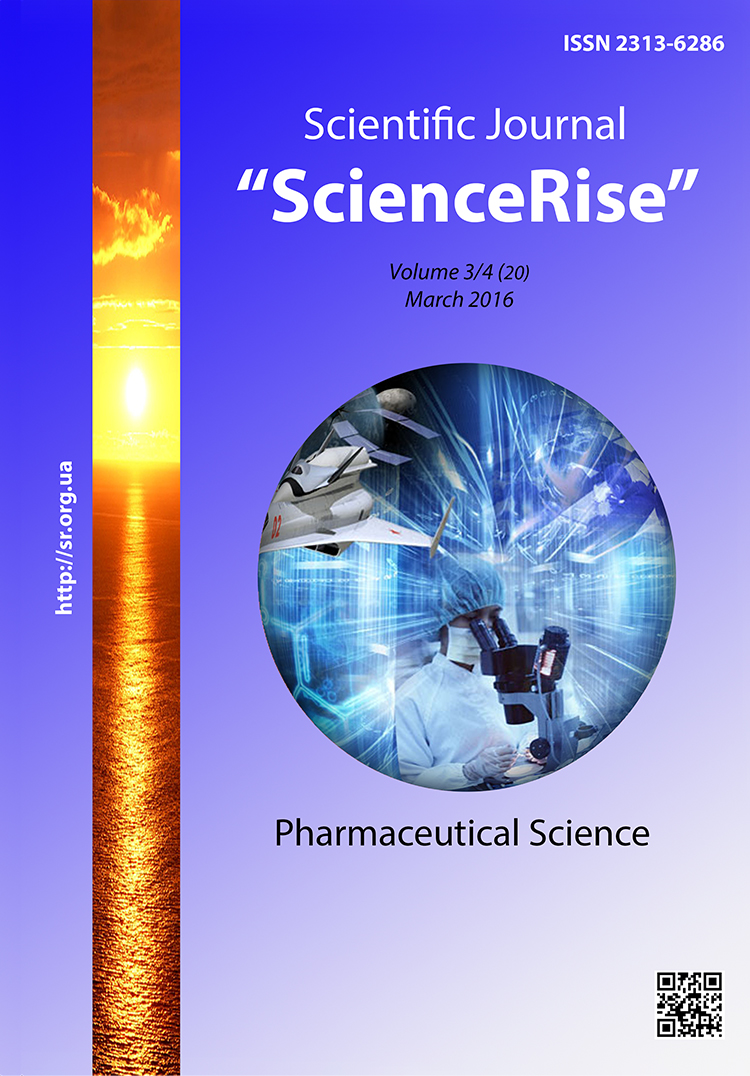Pharmacological research of antimicrobial ointment with anti-inflammatory and wound-healing effect for the needs of military medicine
DOI:
https://doi.org/10.15587/2313-8416.2016.64837Keywords:
pharmacological studies, wound process, ointment, median lethal dose, sensibilization, safety, toxicityAbstract
Aim. To examine an irritating effect, and the presence/absence of sensitizing effect of the «Oflinim» ointment, the acute toxicity has been studied to obtain toxicological specification of the remedy being developed.
Methods. Toxicological specification of the «Oflinim» developed ointment has been studied by the “acute” experiment on warm-blooded animals – albino “Wistar” rats, albino mice, guinea pigs, “Chinchilla” rabbits according to the toxicological, biochemical and statistical methods. Considering the ointment is a drug for external use, its potential toxicological effect for different routes of administration in human’s organism according to the requirements has been studied. Due to the fact that the «Oflinim» ointment contains active pharmaceutical ingredients, which are used both in pharmacy and in medicine, every component is used in low doses, and terms of use is limited to several days, the carcinogenic activity of remedy has not been studied.
To identify toxicological specification of the «Oflinim» developed ointment, determination of safety degree at its both gastrointestinal administration (single and multiple use), and administration through integuments has been examined. Irritating effect of the «Oflinim» ointment when applied to skin (single and multiple use), as well as upon contact with the eyes mucous membranes, has been determined.
Results. It has been determined by pharmacological studies that median lethal dose (LD50) at single application to the skin is more than 2500.0 mg/kg. At single gastrointestinal administration, median lethal dose (LD50) for warm-blooded animals – albino rats and albino mice was more than 5000 mg/kg.
Conclusion. Toxicological specification of the «Oflinim» ointment has been studied by conventional methods and in “acute” experiment on warm-blooded animals – albino rats and albino mice.
It has been determined by pre-clinical trials that the developed dosage form can be estimated as toxicologically safe ((LD50>70 g/kg), and it does not show any allergenic and irritating effect on the eyes mucous membranes and skin
References
Butko, Ya. A. (2010). Farmakokorrektsyya ranevoho protsessa [Farmakokorrektsiya wound healing process]. Pharmacist, 4, 25–29.
Galimov, O. V., Cuisin, S. R., Zakiev, T. Z. et. al (2008). Byokhymycheskye mekhanyzmy zazhyvlenyya ran [Biochemical mechanisms of wound healing]. Bashkir chemical. Phys, 3, 82–84.
Joglo, F., Wozniak, V., Popovich, V. et. al (2002). Dopomizhni rechovyny ta yikh zastosuvannya v tekhnolohiyi likarskykh form [Additives and their applications in technologies dosage forms]. Lviv: Center Of Europe, 95.
Alekseeva, O. G., Duev, L. A. (1978). Allerhyya k promyshlennym khymycheskym soedynenyyam [Allergy to industrial chemical compounds]. Moscow: Medicinа, 272.
Ivanov, Y. I., Pogorelyc, O. N. (1990). Statystycheskaya obrabotka rezultatov medyko-byolohycheskykh yssledovanyy na mykrokalkulyatorakh po prohrammam [Statistical analysis of the results of biomedical research on the calculator in program]. Moscow: Medicina, 217.
Mintser, O. P., Ugarov, B. N., Vlasov, V. V. (2001). Metody obrabotky medytsynskoy ynformatsyy [Methods of processing health information]. Kyiv: Vishcha shkola, 271.
Laita, A. O. (Ed.) (2006). Obshchaya toksykolohyya [General toxicology]. Sankt-Peterburg: ELBI – SPb., 224.
Stefanov, A. V. (Ed.) (2002). Doklynycheskye yssledovanyya lekarstvennykh sredstv [Preclinical studies of drugs]. Kyiv: Avicena, 568.
Sidorov, K. K. (1976). Vvedenye veshchestv v zheludok, v trakheyu, pod kozhu, v venu y druhye puty vvedenyya yadov laboratornym zhyvotnym [Introduction of substances into the stomach, into the trachea, under the skin, into a vein and other routes of administration of poisons to laboratory animals]. Methods for determining the toxicity and hazard of chemical substances. Moscow: Medicine, 87.
Kasparov, A. A., Sanok, V. I. (Eds.) (1986). Toksykometryya khymycheskykh veshchestv zahryaznyayushchykh okruzhayushchuyu sredu [Toxicometry chemical substances polluting the environment]. Moscow: Centre for international projects, 426.
Davies, B., Morris, T. (1993). Physiological parameters of laboratory animals and humans. Pharmacol. Res., 10 (7), 1093–1095.
Downloads
Published
Issue
Section
License
Copyright (c) 2016 Виктория Валентиновна Шматенко

This work is licensed under a Creative Commons Attribution 4.0 International License.
Our journal abides by the Creative Commons CC BY copyright rights and permissions for open access journals.
Authors, who are published in this journal, agree to the following conditions:
1. The authors reserve the right to authorship of the work and pass the first publication right of this work to the journal under the terms of a Creative Commons CC BY, which allows others to freely distribute the published research with the obligatory reference to the authors of the original work and the first publication of the work in this journal.
2. The authors have the right to conclude separate supplement agreements that relate to non-exclusive work distribution in the form in which it has been published by the journal (for example, to upload the work to the online storage of the journal or publish it as part of a monograph), provided that the reference to the first publication of the work in this journal is included.

